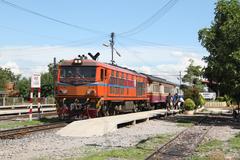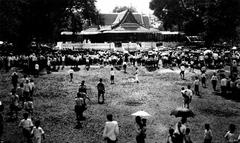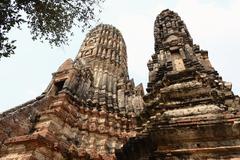Wat Senasanaram Ratworawihan: Visiting Hours, Tickets, and Comprehensive Travel Guide in Phra Nakhon Si Ayutthaya
Date: 04/07/2025
Introduction
Wat Senasanaram Ratworawihan is a distinguished Buddhist temple situated in the heart of Phra Nakhon Si Ayutthaya, Thailand. Renowned for its rich blend of religious, royal, and cultural heritage, the temple offers visitors a window into centuries of Thai artistry, architecture, and spiritual tradition. Established during the late Ayutthaya period and restored under royal patronage in the early Rattanakosin era, Wat Senasanaram is a testament to Thailand’s enduring Buddhist legacy and royal connections. This comprehensive guide provides essential information for visitors, including the temple’s origins, significance, visiting hours, ticketing, travel tips, and nearby attractions, ensuring an enriching and memorable experience.
For a deeper exploration of Ayutthaya’s heritage and Wat Senasanaram’s historical context, consult the Ayutthaya Historical Study Centre and ayutthaya-history.com.
Table of Contents
- Introduction
- Historical Background and Royal Patronage
- Architectural and Artistic Features
- Cultural and Spiritual Significance
- Visitor Information and Practical Tips
- Accessibility and Facilities
- Guided Tours and Special Events
- Nearby Attractions and Ayutthaya Historical Park Context
- Frequently Asked Questions (FAQ)
- Conclusion
- Further Resources
Historical Background and Royal Patronage
Origins and Historical Evolution
Founded during the late Ayutthaya period under King Borommakot (1733–1758), Wat Senasanaram was originally known as Wat Sua, owing to its proximity to royal elephant stables. After the city’s fall in 1767, the temple was restored by King Rama I (1782–1809), who renamed it Wat Senasanaram Ratworawihan and established it as a second-class royal monastery. Subsequent monarchs, including King Rama IV and King Rama V, continued to support and enhance the temple, reinforcing its royal and religious significance (ayutthaya-history.com).
Royal Patronage and Modernization
Wat Senasanaram was the first temple in Ayutthaya to adopt the Thammayut Nikaya discipline, introduced by King Mongkut (Rama IV) to reform Thai Buddhism. King Chulalongkorn (Rama V) further modernized the site, enhancing its role as a center for monastic education and religious ceremonies.
Architectural and Artistic Features
Layout and Key Structures
Encircled by the Khlong Senasanaram canal, the temple complex embodies the ritual hierarchy of Rattanakosin-period royal temples:
- Ordination Hall (Ubosot): The central space for monastic rituals, adorned with late Rattanakosin murals (c. 1924) depicting gathering devas, dhamma puzzles, and royal ceremonies.
- Main Chedi (Stupa): A blend of Ayutthaya and early Rattanakosin styles, serving as a focal point for merit-making.
- Viharas (Assembly Halls): Housing significant Buddha images, these serve as communal worship spaces.
- Ancillary Structures: Include a royal gift pulpit, a symbolic teakwood boat, and unique cubic lotus-form boundary stones (sema) introduced by King Mongkut.
Artistic Highlights
The temple’s murals and decorative elements are noted for their vivid colors and narrative scenes, illustrating Buddhist cosmology and Thai royal traditions. Noteworthy Buddha images, Phra Inplaeng and Phra Sam Phuttha Muni, were relocated from Vientiane after the Lao rebellion in 1828, symbolizing both religious and regional history (ayutthaya-history.com).
Cultural and Spiritual Significance
Wat Senasanaram is more than an architectural marvel; it is an active center for Buddhist practice, monastic education, and community life. The temple hosts important festivals such as Visakha Bucha and Loy Krathong, providing a space for traditional ceremonies, merit-making, and cultural exchange. Its proximity to the former royal palace underscores its historical role at the heart of Ayutthaya’s sacred landscape.
Visitor Information and Practical Tips
Opening Hours and Admission
- Hours: Open daily from 8:00 AM to 5:00 PM.
- Admission: Entry is free, though donations are welcome to support maintenance.
Location and Getting There
Wat Senasanaram is located near the eastern section of Ayutthaya Historical Park, approximately 2 km east of the city center. It is easily accessible by bicycle, tuk-tuk, or local songthaew. Parking is available for private vehicles.
Dress Code and Etiquette
Visitors should dress modestly, covering shoulders and knees. Shoes must be removed before entering sacred buildings. Respectful conduct and quiet are expected within the temple grounds.
Photography
Photography is allowed in most outdoor areas and inside the ubosot, but flash should be avoided to preserve murals. Always observe signage and refrain from photographing during ceremonies or worship without permission.
Best Times to Visit
Early mornings and late afternoons provide cooler temperatures and optimal lighting for photography, with fewer crowds.
Accessibility and Facilities
- Accessibility: The temple grounds are generally flat but may have uneven surfaces and steps in certain areas. Visitors with mobility challenges may require assistance.
- Facilities: Restrooms, shaded seating, and small shops are available nearby. English-language signage is present throughout the main areas.
Guided Tours and Special Events
Guided tours can be arranged on-site or through local agencies, providing deeper historical and cultural insights. During major Buddhist festivals, the temple hosts unique ceremonies and community events, offering visitors a chance to witness living traditions (tripiwi.com).
Nearby Attractions and Ayutthaya Historical Park Context
Wat Senasanaram is ideally situated for combined visits with other key sites within the UNESCO-listed Ayutthaya Historical Park, such as Wat Phra Si Sanphet, Wat Mahathat, and the Ayutthaya Historical Study Centre. The area is easily navigable by bicycle or tuk-tuk, and guided tours often include multiple temples and museums (backpackersthailand.com).
Frequently Asked Questions (FAQ)
Q: What are the visiting hours of Wat Senasanaram Ratworawihan?
A: The temple is open daily from 8:00 AM to 5:00 PM.
Q: Is there an entrance fee?
A: Entry is free, though donations are appreciated.
Q: Are guided tours available?
A: Yes, guided tours can be arranged on-site or through local operators.
Q: Is the temple accessible for visitors with disabilities?
A: Most areas are accessible, but some steps and uneven surfaces may require assistance.
Q: Can I take photos inside the ubosot?
A: Photography is allowed, but avoid using flash and be mindful of ongoing ceremonies.
Conclusion
Wat Senasanaram Ratworawihan stands as a living testament to Ayutthaya’s royal and religious legacy, blending historic architecture, vibrant artistic traditions, and active community life. Its serene setting, free admission, and proximity to other major attractions make it an essential stop for any visitor to Ayutthaya. By observing respectful etiquette, planning your visit during cooler hours, and considering guided tours, you’ll gain a deeper appreciation for this remarkable site and the broader Ayutthaya Historical Park.
For more images and visual references, visit the Wikimedia Commons gallery.
Further Resources
- Ayutthaya Historical Study Centre
- Ayutthaya-history.com - Wat Senasanaram
- Tripiwi Ayutthaya Travel Guide
- Asia Holiday Guide
- Backpackers Thailand
- IGOA Adventure
For more travel tips and multimedia guides, download the Audiala app and follow our social media channels. Start your journey into Thailand’s storied past today!


